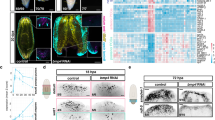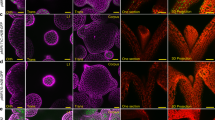Abstract
THE formulation of a general model of gene regulation in eukaryotic organisms would be facilitated were it known when the molecular events responsible for reprogramming of genetic information occur during the cell cycle. Evidence from various systems in which animal cells differentiate in vivo and in vitro suggests that certain characteristics of the fully differentiated state are not manifest until the cells undergo DNA synthesis and nuclear division1. Similarly the differentiation of wound vessel members (WVM) in plant parenchyma tissue is thought to occur only after cells have replicated at least once in inductive conditions2.
This is a preview of subscription content, access via your institution
Access options
Subscribe to this journal
Receive 51 print issues and online access
$199.00 per year
only $3.90 per issue
Buy this article
- Purchase on Springer Link
- Instant access to full article PDF
Prices may be subject to local taxes which are calculated during checkout
Similar content being viewed by others
References
Holtzer, H., Mayne, R., Weintraub, H., and Campbell, G., in The Biochemistry of Gene Expression in Higher Organisms (edit. by Pollak, J. K., and Lee, J. W.), 287–304 (Australia and New Zealand Book Co., Sydney, 1972).
Torrey, J. G., Fosket, D. E., and Hepler, P. K., Am. Scient., 59, 338–352 (1971).
Dalessandro, G., and Roberts, L. W., Am. J. Bot., 58, 378–385 (1971).
Freundlich, H. F., Jb. Wiss. Bot., 46, 137–206 (1908).
Sinnott, E. W., and Bloch, R., Am. J. Bot., 32, 151–156 (1945).
Dalessandro, G., Ann. Bot., 37, 375–382 (1973).
Brunori, A., Caryologia, 24, 209–215 (1971).
Haber, A. H., Foard, D. E., and Perdue, S. W., Pl. Physiol., Lancaster., 44, 463–467 (1969).
Foard, D. E., and Haber, A. H., Am. J. Bot., 48, 438–446 (1961).
Haber, A. H., and Foard, D. E., Am. J. Bot., 51, 151–159 (1964).
Vonderhaar, B. K., and Topper, Y. J., J. Cell Biol. 63, 707–712 (1974).
Selman, K., and Kafatos, F. C., Cell Differentiation, 3, 81–94 (1974).
Kastern, W. H., and Krishnakumaran, A., Cell Differentiation, 4, 45–53 (1975).
Monahan, J. J., and Hall, R. H., CRC Critical Revs Biochem., 2, 67–112 (1974).
Author information
Authors and Affiliations
Rights and permissions
About this article
Cite this article
TURGEON, R. Differentiation of wound vessel members without DNA synthesis, mitosis or cell division. Nature 257, 806–808 (1975). https://doi.org/10.1038/257806a0
Received:
Accepted:
Issue Date:
DOI: https://doi.org/10.1038/257806a0
This article is cited by
-
Tracheary element differentiation in Zinnia mesophyll cell cultures
Plant Growth Regulation (1993)
-
Reprogramming of cells following wounding in pea (Pisum sativum L.) roots. II. The effects of caffeine and colchicine on the development of new vascular elements
Protoplasma (1982)
-
Direct differentiation of tracheary elements in cultured explants of gamma-irradiated tubers of Helianthus tuberosus
Planta (1981)
-
Hormone regulation of development in plant cells
In Vitro (1978)
-
Lightmicroscopical histochemistry of hydrolases in the root tip of lima beans,Phaseolus lunatus L., in relation to cell differentiation and wound regeneration
Protoplasma (1977)
Comments
By submitting a comment you agree to abide by our Terms and Community Guidelines. If you find something abusive or that does not comply with our terms or guidelines please flag it as inappropriate.



